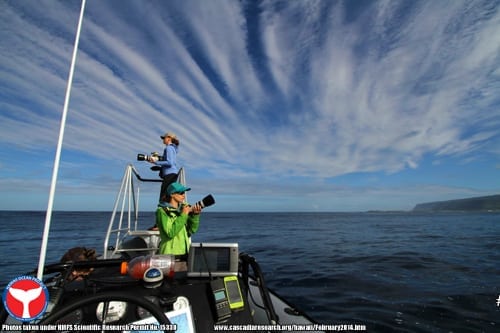A Visual Guide To Common Humpback Whale Behavior
There is nothing more exciting than seeing a 30-ton whale throwing itself out of the ocean like a spinner dolphin on one of our whale watches. Luckil...

By Delphine Berbigier
I thought it was a good sign that we started the day with a sighting of a small reef shark right in the harbor, just at sunrise. From the dock, Millie jokingly warned Daniel, who was driving the boat, to not fall in the water. Brenda was getting ready to tie up the Zodiac while Elisa was hosing the trailer. Like a well-oiled machine, everyone knew what they had to do, did it fast, and in no time we were speeding off to the deep waters off of Kauai's west coast, Dr. Robin Baird behind the wheel. I was invited for two days to join Cascadia Research Collective's 2014 10-day field project off Kauai, as an extra pair of eyes scanning the water looking for whales and dolphins, and taking notes and photos to document the efforts.
The project is commissioned by the US Navy, which operates the nearby Pacific Missile Range Facility (PMRF) at Barking Sands, "the world's largest instrumented multi-environmental range capable of supported surface, subsurface, air, and space operations simultaneously." This means the Navy uses the area for a wide range of different operations and trainings, including the Submarine Commander Course, scheduled for late February. One of the main purposes of the field project is to obtain information on the movements of several species of toothed whales thanks to satellite tags before, during and after that training course.
So we're out on our little RIB, looking for whales. Clouds melt into pelting rain, and we're forced to head back to the harbor for lunch without any sighting, apart from a Laysan albatross and a petrel. The weather seems to clear up, and we go out again, northbound. Humpback whales are abundant at this time of the year, and they often give us a false alarm: they are not the whales we're looking for. Fortunately, we get some help. M3R, part of the Navy's monitoring program, calls Robin on the radio "We have a pod of beaked whales feeding off of hydrophone 4-5." The PMRF features 1,100 square miles of instrumented range, which includes over 200 hydrophones. These pick up on the clicks and whistles toothed whales emit to echo-locate and find their prey. Through a process of triangulation, the Navy can obtain a pretty accurate location of a pod, and they send us there. Excitement is in the air . . .
Stay tuned for more in our next installment of the Hawaii Ocean Project Blog!
There is nothing more exciting than seeing a 30-ton whale throwing itself out of the ocean like a spinner dolphin on one of our whale watches. Luckil...
When you join us on a whale watch tour on Maui, breaching is one of the common actions you're likely to see. Breaching is when a whale throws its ent...
Seeing whales on a whale watch tour is awesome. No doubt about that. But do you know what else is awesome? Seeing dolphins! But is it legal to swim wi...
